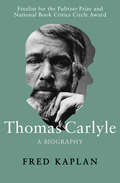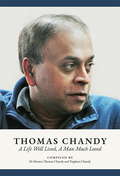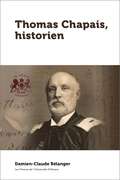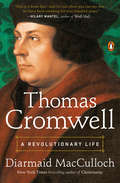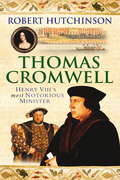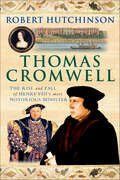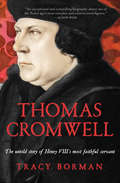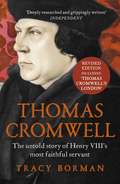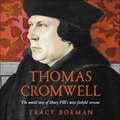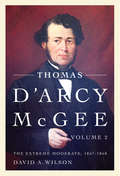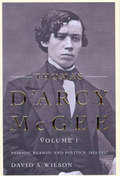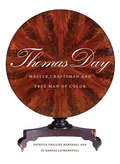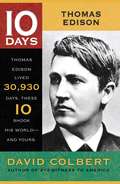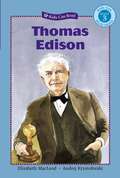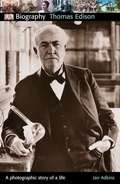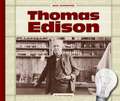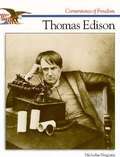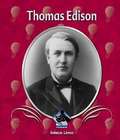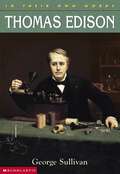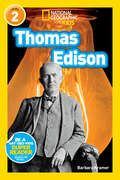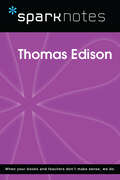- Table View
- List View
Thomas Betterton
by David RobertsRestoration London's leading actor and theater manager Thomas Betterton has not been the subject of a biography since 1891. He worked with all the best-known playwrights of his age and with the first generation of English actresses; he was intimately involved in the theater's responses to politics, and became a friend of leading literary men such as Pope and Steele. His innovations in scenery and company management, and his association with the dramatic inheritance of Shakespeare, helped to change the culture of English theater. David Roberts's entertaining study unearths new documents and draws fresh conclusions about this major but shadowy figure. It contextualizes key performances and examines Betterton's relationship to patrons, colleagues and family, as well as to significant historical moments and artifacts. The most substantial study available of any seventeenth-century actor, Thomas Betterton gives one of England's greatest performing artists his due on the tercentenary of his death.
Thomas Carlyle: A Biography
by Fred KaplanPulitzer Prize finalist: &“The definitive biography&”of the Victorian-era writer and historian (The Times Literary Supplement). A Pulitzer finalist that draws upon years of research and unpublished letters, Thomas Carlyle examines the life of the Victorian genius. Carlyle was the author of Sartor Resartus and The French Revolution: A History, and he possessed one of literature&’s most flamboyant prose styles. Despite a childhood beset by anxiety and illness, Carlyle was indefatigable in his literary production. Fred Kaplan delves into the author&’s intense personal life, which includes his turbulent marriage to author Jane Baillie Welsh and his disillusionment with religion. Kaplan is a devoted and sensitive explicator, vividly resurrecting both Carlyle and his Victorian setting.
Thomas Chandy: A Life Well Lived, A Man Much Loved
by Dr Monica Thomas ChandyThis book is a tribute to a man, who was born and raised in an unassuming Kerala town; rose up the corporate ladder, only to leave it all behind to help found Save The Children India, working towards better living and rights for the most vulnerable children of India. The book brings together many memories and anecdotes, shared by family, friends, colleagues, industry doyens, corporate heads, intellectuals and theologians, who knew him, loved him, or who held his work ethics and life principles in high regard.
Thomas Chapais, historien (Amérique française)
by Damien-Claude BélangerThomas Chapais est une des grandes figures politiques et intellectuelles canadiennes-françaises du début du XXe siècle. Nommé au Conseil législatif de Québec en 1892, puis au Sénat du Canada en 1919, il a joué un rôle de premier plan dans les débats entourant la réforme du système d’éducation du Québec et dans les crises scolaires du Manitoba et de l’Ontario. Pourtant, c’est surtout de l’historien et non de l’homme politique dont on se souvient aujourd’hui. Biographe de Jean Talon et du marquis de Montcalm et auteur d’une importante synthèse d’histoire du Canada, Thomas Chapais formule un récit d’histoire cohérent qui contribue à l’avancement des connaissances et qui alimente d’importants débats historiographiques. Ses travaux forment un jalon essentiel dans l’histoire de la culture intellectuelle du Canada français. L’historien est en effet le dernier grand représentant du loyalisme canadien-français, doctrine qui repose notamment sur une interprétation particulière de la Conquête de 1760. Dans cette première étude d’envergure consacrée à Chapais, Damien-Claude Bélanger se penche sur son oeuvre d’historien pour comprendre son émergence, son contexte socioculturel, ses idées fortes, son influence et son destin critique.Publié en français
Thomas Cromwell: A Revolutionary Life
by Diarmaid MacCullochThe long-awaited biography of the genius who masterminded Henry VIII's bloody revolution in the English government, which reveals at last Cromwell's role in the downfall of Anne Boleyn. <P><P>Since the sixteenth century we have been fascinated by Henry VIII and the man who stood beside him, guiding him, enriching him, and enduring the king's insatiable appetites and violent outbursts until Henry ordered his beheading in July 1540. After a decade of sleuthing in the royal archives, Diarmaid MacCulloch has emerged with a tantalizing new understanding of Henry's mercurial chief minister, the inscrutable and utterly compelling Thomas Cromwell.History has not been kind to the son of a Putney brewer who became the architect of England's split with Rome. <P><P>Where past biographies portrayed him as a scheming operator with blood on his hands, Hilary Mantel reimagined him as a far more sympathetic figure buffered by the whims of his master. So which was he--the villain of history or the victim of her creation? MacCulloch sifted through letters and court records for answers and found Cromwell's fingerprints on some of the most transformative decisions of Henry's turbulent reign. But he also found Cromwell the man, an administrative genius, rescuing him from myth and slander. <P><P>The real Cromwell was a deeply loving father who took his biggest risks to secure the future of his son, Gregory. He was also a man of faith and a quiet revolutionary. In the end, he could not appease or control the man whose humors were so violent and unpredictable. But he made his mark on England, setting her on the path to religious awakening and indelibly transforming the system of government of the English-speaking world.
Thomas Cromwell: The Rise And Fall Of Henry VIII's Most Notorious Minister
by Robert HutchinsonThe rise and fall of Henry's notorious minister - the most corrupt Chancellor in English historyThe son of a brewer, Cromwell rose from obscurity to become Earl of Essex, Vice-Regent and High Chamberlain of England, Keep of the Privy Seal and Chancellor of the Exchequer. He maneuvered his way to the top by intrigue, bribery and sheer force of personality in a court dominated by the malevolent King Henry.Cromwell pursued the interests of the king with single-minded energy and little subtlety. Tasked with engineering the judicial murder of Anne Boleyn when she had worn out her welcome in the royal chamber, he tortured her servants and relations, then organised a 'show trial' of Stalinist efficiency. He orchestrated the 'greatest act of privatisation in English history': the seizure of the monasteries. Their enormous wealth was used to cement the loyalty of the English nobility, and to enrich the crown. Cromwell made himself a fortune too, soliciting colossal bribes and binding the noble families to him with easy loans. He came home from court literally weighed down with gold.
Thomas Cromwell: The Rise And Fall Of Henry VIII's Most Notorious Minister
by Robert HutchinsonThe rise and fall of Henry's notorious minister - the most corrupt Chancellor in English historyThe son of a brewer, Cromwell rose from obscurity to become Earl of Essex, Vice-Regent and High Chamberlain of England, Keep of the Privy Seal and Chancellor of the Exchequer. He maneuvered his way to the top by intrigue, bribery and sheer force of personality in a court dominated by the malevolent King Henry.Cromwell pursued the interests of the king with single-minded energy and little subtlety. Tasked with engineering the judicial murder of Anne Boleyn when she had worn out her welcome in the royal chamber, he tortured her servants and relations, then organised a 'show trial' of Stalinist efficiency. He orchestrated the 'greatest act of privatisation in English history': the seizure of the monasteries. Their enormous wealth was used to cement the loyalty of the English nobility, and to enrich the crown. Cromwell made himself a fortune too, soliciting colossal bribes and binding the noble families to him with easy loans. He came home from court literally weighed down with gold.
Thomas Cromwell: The Rise and Fall of Henry VIII's Most Notorious Minister
by Robert HutchinsonThe son of a brewer, Thomas Cromwell rose from obscurity to become the confidant of the King and one of the most influ ential men in British history. Cromwell drafted the law that allowed Henry VIII to divorce his first wife and marry Anne Boleyn, setting into motion the brutal Pro testant Reformation. Over the course of his career, Cromwell amassed a fortune through bribery and theft, and created many enemies along the way. His fall was spectacular—beheaded out side the Tower of London, his boiled head was placed on a spike above the London Bridge.Rich in incident and colorful detail, this is narrative history at its finest.
Thomas Cromwell: The Untold Story of Henry VIII's Most Faithful Servant
by Tracy BormanThomas Cromwell has captured the imagination for centuries, including recently in Hilary Mantel's Wolf Hall and its stage and television adaptations. Long reviled as a Machiavellian schemer who stopped at nothing in his quest for power, in Thomas Cromwell, Tracy Borman reveals a different side of one of the most notorious figures in history: that of a caring husband and father, a fiercely loyal servant and friend, and a revolutionary who helped make medieval England into a modern state.Born in the mid-1480s to a lowly blacksmith, Cromwell left home to make his fortune abroad, serving in the French army, and working in Florence at the height of the Renaissance. Back in England, Cromwell built a flourishing legal practice, became the protégé of Cardinal Thomas Wolsey, and went on to become Henry VIII's top aide, where he was at the heart of the most momentous events of his time, from the Reformation to the downfall of Anne Boleyn. His seismic political, religious, and social reforms can still be felt today.
Thomas Cromwell: The untold story of Henry VIII's most faithful servant
by Tracy Borman'This deeply researched and grippingly written biography brings Cromwell to life and exposes the Henrician court in all its brutal, glittering splendour.' Kate Williams, IndependentThomas Cromwell's life has made gripping reading for millions through Hilary Mantel's bestselling novels Wolf Hall and Bring Up the Bodies. But who was the real Cromwell? In this major new biography, leading historian Tracy Borman examines the life, loves and legacy of the man who changed the shape of England forever.Born a lowly tavern keeper's son, Cromwell rose swiftly through the ranks to become Henry VIII's right hand man, and one of the most powerful figures in Tudor history. The architect of England's break with the Roman Catholic Church and the dissolution of the monasteries, he oversaw seismic changes in England's history. Influential in securing Henry's controversial divorce from Catherine of Aragon, many believe he was also the ruthless force behind Anne Boleyn's downfall and subsequent execution. Although for years he has been reviled as a Machiavellian schemer who stopped at nothing in his quest for power, Thomas Cromwell was also a loving husband, father and guardian, a witty and generous host, and a loyal and devoted servant. With fresh research and new insights into Cromwell's family life, his household and his close relationships, Tracy Borman Tracy Borman tells the true story of Henry VIII's most faithful servant.
Thomas Cromwell: The untold story of Henry VIII's most faithful servant
by Tracy Borman'This deeply researched and grippingly written biography brings Cromwell to life and exposes the Henrician court in all its brutal, glittering splendour.' Kate Williams, IndependentThomas Cromwell's life has made gripping reading for millions through Hilary Mantel's bestselling novels Wolf Hall and Bring Up the Bodies. But who was the real Cromwell? In this major new biography, leading historian Tracy Borman examines the life, loves and legacy of the man who changed the shape of England forever.Born a lowly tavern keeper's son, Cromwell rose swiftly through the ranks to become Henry VIII's right hand man, and one of the most powerful figures in Tudor history. The architect of England's break with the Roman Catholic Church and the dissolution of the monasteries, he oversaw seismic changes in England's history. Influential in securing Henry's controversial divorce from Catherine of Aragon, many believe he was also the ruthless force behind Anne Boleyn's downfall and subsequent execution. Although for years he has been reviled as a Machiavellian schemer who stopped at nothing in his quest for power, Thomas Cromwell was also a loving husband, father and guardian, a witty and generous host, and a loyal and devoted servant. With fresh research and new insights into Cromwell's family life, his household and his close relationships, Tracy Borman Tracy Borman tells the true story of Henry VIII's most faithful servant.
Thomas Cromwell: The untold story of Henry VIII's most faithful servant
by Tracy BormanThomas Cromwell is known to millions as the leading character in Hilary Mantel's bestselling Wolf Hall and Bring Up the Bodies. But who was the real Cromwell? Born a lowly tavern keeper's son, Cromwell rose swiftly through the ranks to become Henry VIII's right hand man, and one of the most powerful figures in Tudor history. The architect of England's break with the Roman Catholic Church and the dissolution of the monasteries, he oversaw seismic changes in our country's history. Influential in securing Henry's controversial divorce from Catherine of Aragon, many believe he was also the ruthless force behind Anne Boleyn's downfall and subsequent execution. But although for years he has been reviled as a Machiavellian schemer who stopped at nothing in his quest for power, Thomas Cromwell was also a loving husband, father and guardian, a witty and generous host, and a loyal and devoted servant. With new insights into Cromwell's character, his family life and his close relationships with both Cardinal Wolsey and Henry VIII, joint Chief Curator of Historic Royal Palaces Tracy Borman examines the life, loves and legacy of the man who changed the shape of England forever.(P)2014 Hodder & Stoughton
Thomas D'Arcy McGee
by David A. WilsonThomas D'Arcy McGee: Passion, Reason, and Politics, 1825-1857, the first volume in a two-part biography, explores the development of those principles in Ireland and the United States. From his early temperance speeches in Wexford, Ireland, David Wilson follows McGee across the Atlantic, where at nineteen he became the editor of America's leading Irish newspaper, and traces his subsequent involvement with the Young Ireland movement, his reactions to the Famine, and his role in the Rising of 1848.
Thomas D'Arcy McGee: Passion, Reason, and Politics, 1825-1857
by David A. WilsonA brilliant writer, outstanding orator, and charismatic politician, Thomas D'Arcy McGee is best known for his prominent role in Irish-Canadian politics, his inspirational speeches in support of Canadian Confederation, and his assassination by an Irish revolutionary who accused him of betraying his earlier Irish nationalist principles. Thomas D'Arcy McGee, the first volume in a two-part biography, explores the development of those principles in Ireland and the United States. David Wilson follows McGee from Wexford, Ireland across the Atlantic to Boston, where at nineteen he became the editor of America's leading Irish newspaper, and traces his subsequent involvement with the Young Ireland movement, his reactions to the Famine, and his role in the Rising of 1848. Wilson goes on to examine McGee's experiences as a political refugee in the United States, where his increasing disillusionment with revolutionary Irish nationalism and his opposition to American nativism propelled him towards conservative Catholicism and sent him on a trajectory that ultimately led to Canada - his experiences are the subject of volume 2, Thomas D'Arcy McGee: The Extreme Moderate, 1857-1868.
Thomas D'Arcy McGee: The Extreme Moderate, 1857-1868
by David A. WilsonAfter a tumultuous career as a revolutionary in Ireland and an ultra-conservative Catholic in the United States, Thomas D'Arcy McGee moved to Canada in 1857, where he became a force for moderation and the leading Irish Canadian politician in the country. Determined that Canada should avoid the ethno-religious strife that afflicted Ireland, he articulated an inclusive, broad-minded nationalism based on generosity of spirit, a willingness to compromise, and a reasonable balance between order and liberty. To realize his vision, McGee became a strong supporter of the "new northern nationality." A spellbinding orator who emerged as the youngest and most intellectually gifted of the Fathers of Confederation, he fought what he saw as the atavistic and intolerant elements of Canadian life - the Orange Order, with its strident anti-Catholicism; the opponents of separate schools, whom he viewed as enemies of minority rights; and above all the Fenian Brotherhood, with its dreams of revolutionizing Ireland and annexing Canada to the United States. Convinced that compromise with Fenianism was impossible, he set out to destroy the movement through a strategy of confrontation and polarization - channeling his earlier extreme tendencies in the service of moderation and attempting to reduce the influence of Fenianism within his own community. In the process, he alienated many of his former supporters, who came to regard him as a traitor who sacrificed the cause of Irish nationalism on the altar of personal ambition. On 7 April 1868, McGee was assassinated on the doorstep of his Ottawa boarding house. As someone who took an uncompromising stand against militants within his own ethno-religious community, and who attempted to balance core values with minority rights, McGee has become increasingly relevant in today's complex multicultural society.
Thomas Day: Master Craftsman and Free Man of Color
by Patricia Phillips Marshall Jo Ramsay LeimenstollThomas Day (1801-61), a free man of color from Milton, North Carolina, became the most successful cabinetmaker in North Carolina--white or black--during a time when most blacks were enslaved and free blacks were restricted in their movements and activities. His surviving furniture and architectural woodwork still represent the best of nineteenth-century craftsmanship and aesthetics. In this lavishly illustrated book, Patricia Phillips Marshall and Jo Ramsay Leimenstoll show how Day plotted a carefully charted course for success in antebellum southern society. Beginning in the 1820s, he produced fine furniture for leading white citizens and in the 1840s and '50s diversified his offerings to produce newel posts, stair brackets, and distinctive mantels for many of the same clients. As demand for his services increased, the technological improvements Day incorporated into his shop contributed to the complexity of his designs. Day's style, characterized by undulating shapes, fluid lines, and spiraling forms, melded his own unique motifs with popular design forms, resulting in a distinctive interpretation readily identified to his shop. The photographs in the book document furniture in public and private collections and architectural woodwork from private homes not previously associated with Day. The book provides information on more than 160 pieces of furniture and architectural woodwork that Day produced for 80 structures between 1835 and 1861. Through in-depth analysis and generous illustrations, including over 240 photographs (20 in full color) and architectural photography by Tim Buchman, Marshall and Leimenstoll provide a comprehensive perspective on and a new understanding of the powerful sense of aesthetics and design that mark Day's legacy.
Thomas Edison
by David ColbertYou're about to be an eyewitness to the top ten days in Thomas Edison's life, including: An instinctive moment of bravery that launched a career A lucky break that freed him for a life of invention An incredible boast that he quickly proved true A flash of insight that lit the world And the creation of our favorite pastime, the movies. These days and five others shook Edison's world - and yours.
Thomas Edison
by Elizabeth MacleodMeet Thomas Edison - world-famous inventor. The story of his many inventions, including the phonograph and the light bulb, is told in level-appropriate language.
Thomas Edison
by Jan AdkinsFilled with archival photographs and amazing facts, this groundbreaking series introduces young readers to some of history's most interesting and influential characters. The series now features a refreshed design, taking the series' original look in a more modern direction. Thomas Edison tells the story of the famous inventor, from his childhood as an "addled" student, to his reign as the "Wizard of Menlo Park," where he developed the electric light bulb, the phonograph, and many other inventions still in use today.
Thomas Edison (Basic Biographies)
by Susan KesselringA very simple introduction to the life and accomplishments of noted scientist and inventor Thomas Alva Edison.
Thomas Edison (Cornerstones of Freedom)
by Nicholas NirgiotisChildren's biography of the famous American inventor of the practical electric light.
Thomas Edison (First Biographies)
by Rebecca GomezAn introduction to the life of the man who developed the electric light bulb and many other inventions.
Thomas Edison (In Their Own Words Ser.)
by George SullivanIn Their Own Words: Thomas Edison tells the exciting story of Edison's life using his laboratory notes, business records, and personal recollections. "I find out what the world needs. Then I go ahead and try to invent it." With these words, Thomas Edison explains how he developed ideas and turned them into useful inventions. Although he is most famous for inventing the lightbulb, Edison is credited with hundreds of inventions. The young boy who did poorly in school became one of the most famous men in America. This exciting new biography of Thomas Edison will enlighten, as well as entertain, elementary school kids. <P> *This textbook has been transcribed in UEB, formatted according to Braille textbook formats, proofread and corrected.
Thomas Edison (Readers Bios)
by Barbara KramerLearn all about Thomas Edison, one of the most important figures in American history, in this colorful, inviting, and entertaining biography. This carefully leveled reader is written in an easy-to-grasp style to encourage the inventors of tomorrow!
Thomas Edison (SparkNotes Biography Guide)
by SparkNotesThomas Edison (SparkNotes Biography Guide) Making the reading experience fun! SparkNotes Biography Guides examine the lives of historical luminaries, from Alexander the Great to Virginia Woolf. Each biography guide includes:An examination of the historical context in which the person lived A summary of the person&’s life and achievements A glossary of important terms, people, and events An in-depth look at the key epochs in the person&’s career Study questions and essay topics A review test Suggestions for further reading Whether you&’re a student of history or just a student cramming for a history exam, SparkNotes Biography guides are a reliable, thorough, and readable resource.

